-

人教版高中英语必修3Healthy Eating说课稿4篇
Language learning needs a context, which can help the learners to understand the language and then can product comprehensible output, so computer has the advantages to make the materials attractive.Part 3 Learning MethodsTask-based, self-dependent and cooperative learningPart 4 Teaching ProcedureStep One Lead-in“Interest is the best teacher.” Therefore, at the very beginning of the class, I should spark the students’ mind to focus on the centre topic “the band”. I’ll show some pictures of food to attract their attention and then bring some questions.Question:What kind of food they like?What should go into a good meal?The answers must relate to the diet. After this, the students will be eager to know something about a balance diet and this is the very time to naturally lead the class into Step 2Step 2 Reading for information: skimming and scanning In this step, I use Task-based Language Teaching method, which can give students a clear and specific purpose while skimming and scanning the context.Task 1 General ideaThe students will be asked to just glance at the title and the pictures of the passage, and then guess what they will read in the text. And they’ll be divided into groups of four to have a discussion.The purpose is to inspire the students to read actively, not passively. In addition, the task is to develop the students’ reading skill by making prediction and to encourage the students to express their thoughts in English and cooperate with each other.Task 2 Main idea of each paragraphCooperative learning can raise the students’ interest and create an atmosphere of achievement. Based on this theory, I divide the whole class into 4 groups to skim the whole text and get the main idea of each paragraph.

人教版高中英语必修4Working The Land说课稿3篇
Knowledge objectives:(1) to make Ss grasp the usage of words, expressions and sentence structures: statistics, struggle, thanks to, rid of, some patterns for persuasion, the “ing” form as subject and object;(2)to use learnt knowledge to persuade sb.Ability objectives:(1) to develop Ss’ reading skills(skimming, scanning, word guessing);(2) to improve Ss’ speaking, communicating and cooperating skills.Emotional objectives:to make Ss know the contribution of Yuan,and learn his spirit and his simple life time.Teaching important and difficult points:(1) some words, expressions and sentence structures mentioned above;(2)the content of the text;(3)training their reading and speaking skills.Teaching methods: CLT, TBLT,QT.Learning strategies: CLS, QLS, TBLS.Teaching procedures:Step 1 lead-in: (1) teacher plays a piece of recent news from CCTV about the harvest of the super hybrid rice, and ask students whether they know Yuan or not, and talk about him and his contribution.(2)Brain storm: let Ss describe Yuan in their minds including his appearance, his living condition and so on.Step 2 fast reading tasks:(1)teacher introduces Yuan and super hybrid rice(2)make Ss read the text as fast as possible with questions. Such as: what’s the general ideaof this passage? What’s Yuan’ dream? (skimming and scanning skill)Step 3 intensive reading tasks(1)let Ss read the text silently, find topic sentence of each paragraph and draw the difficult sentences and the knowledge what they don’t understand.(words guessing)(2)teacher and Ss talk about the important words, expressions and sentences together, and ask Ss to retell the content of the text.(summarizing and paraphrasing)(3)teacher summarize this part.(4) read again following the courseware.

人教版高中英语必修3The million pound bank note说课稿3篇
在接下来的细读环节,我套用了高考对阅读理解的考查方式设置了5个问题,分别为三个推理判断题,一个细节题和一个主旨大意题。学生需要对文章的内容进行分析、归纳、推理、猜测等高级思维活动才能做出正确的回答。【设计意图】这一过程是对学生进行细读的训练,培养学生获取特定信息和挖掘文章深层次信息的能力。第三环节:Intensive-reading (精读) 15′第三个环节精读,既是最重要的环节,也是突破本课重难点的关键。首先,让学生思考剧本中人物看到百万英镑前后的态度发生了怎样的变化。其次,让学生仔细阅读文章,找出可以表现人物态度变化的具体的语言和动作。最后,让学生总结人物的态度发生变化的根本原因是什么,从而引出Money Talks, 供学生思考。【设计意图】通过一系列的活动培养学生学习从人物的语言和动作探究人物的心理,使学生进一步体会戏剧语言的魅力,从而对文章背后所反映的社会问题进行思考,也为下一步的讨论环节做好铺垫。

人教版高中英语必修5First aid说课稿6篇
In this class, I have 3 teaching aims, that is, knowledge aims, ability aims and emotion aims.1) Knowledge-Teach students new words and expressions, such as temporary, bleed,sprain choke, first aid, fall ill and so on.-Enable students to have a better understanding for some basic knowledge of first aid.2) Ability-Train students’ speaking, reading and writing abilities by different teaching activities, such as skimming, comprehending, team work, role play, retelling and writing.-Develop students’ reading strategy on how to move general idea to specific information.3) Emotion-Promote students’ awareness of giving first aid.- Cultivate students’ creativities.Then let’s come to my teaching methods and activities.III. Teaching methods and activities:To achieve different teaching aims, various kinds of teaching methods and activities will be adopted throughout this period, such as TBL (task-based learning), skimming, team work, brainstorm and others, which can offer students opportunities to fulfill tasks in which they can use language to achieve a specific outcome.IV. Teaching aids:Computer and blackboardV. Teaching important points:1) Make students have a clear mind for the structure of the text.2) Help students understand the theme of the text.VI. Teaching difficulties:1) So many new words may affect students’ understanding.2) How to get students to know about the functions of the skin and thecauses, characteristics and treatments for different degree burns,and the knowledge about giving first aid. VII. Blackboard design:

人教版高中英语必修5Great scientists说课稿4篇
通过写文章梗概,培养学生综合运用语言的能力,学习用恰当的英语描述科学家的故事。这是本课的教学难点。教师可以使用完形填空的方式来帮助学生整理语篇,从而来降低难度。本课的教学重点的突破方法是:在阅读前,让学生初步了解得出科学观点所需要的基本程序,从而轻松而自然地导入文章的阅读;在阅读过程中,由易到难设计快速阅读和精读的问题,层层推进各种阅读活动,让学生对阅读内容从整体感知到细节理解,最后深层读懂整篇文章,同时加强阅读策略的指导,让每个学生都主动参与课堂教学活动,最终达到提高阅读能力的目的。Step 4 Post-readingGroup Activities四人小组共同合作,在老师的适当指导下,就以下2个问题展开讨论,让学生就所知、所学、所感和所想融入话题,然后抽若干同学代表作小组发言。1. What do you think about John Snow, and what should we learn from him?2. Cholera was 19th century disease, which two diseases are similar to cholera today? Why?

人教版高中英语必修5Life in the Future说课稿5篇
Good afternoon, everyone. It’s my great pleasure to be here sharing my lesson with you. The content of my lesson is Senior English for China Book5 Unit 3 Life in the Future. I’ll be ready to begin this lesson from six parts: Analysis of the teaching material, Analysis of the students, Teaching aims and important and difficult points, Teaching methods and aids, Teaching procedures, and Blackboard design. First, let me talk about the teaching material.Part 1 Analysis of the Teaching Material:This unit is about what human beings’ life will be like in about one thousand years. By studying of this unit, we’ll Enable the students to know the changes in humans’ life and some new inventions bringing about the change and develop the interest in science. This lesson plays an important part in the English teaching in this unit. This is an important lesson in Book Five. From this lesson, it starts asking the Ss to grasp contents of each passage. Therefore, this lesson is in the important position of the teaching material. If the Ss can learn it well, it will be helpful to make the Ss learn the rest of this unit.Part 2 Analysis of the SsAs Senior2 Ss, they are at different levels of English fluency, some of them have lost interest in English. So during the lesson, I arrange a variety of activities to let all of them join in to attract their interest and let them be confident and taste the joy of success.

人教版高中英语必修5Making the news说课稿4篇
今天我们来介绍一下必修五第四单元的授课方式。这个单元的题目是Making the news。应该是学生比较感兴趣的话题,学生往往对新闻工作充满好奇,所以我们可以利用这个机会多设计一些师生互动和学生互动,来激发起学习的积极性,提高学习效率。同时我们可以利用这个单元不仅帮助学生掌握语言知识,培养语言能力,同时让其了解新闻工作的重要性,培养起社会智能感。这个单元分为六个课时,它的教学目标是这样的:语言目标是掌握词汇表中的常用单词和短语,掌握倒装句的一些基本用法。 技能目标是能初步掌握约会的基本句型并在真实的场景下正确运用。新闻报道类文章的写作技能。采访的基本规范和沟通技能。情感目标是对新闻报道的客观性和真实性有更好的理解。对新闻记者的职业有更深入的了解,并能体会其工作的重要性。下面我们来介绍一下第一课时的授课方式,第一课的教学目标是这样的第一课时的教学目标语言目标:单词:Occupation, journalist, editor, photographer, curious, personality, enthusiasm

人教版高中英语必修5The United Kingdom说课稿4篇
Teaching Aims:Knowledge 1. Get the students to learn the useful new words and expressions in this section. Aims:2. Let the students learn about how the UK was formed and the four groups of invaders.1. Develop students’ reading ability and let them learn different Ability reading skills. Aims:2. Enable students to learn to talk about the United Kingdom and the Union Jack Emotional 1. Let students know more about the UK2. Develop students’ sense of cooperative learning Aims:Teaching Important Points:1. Let the students learn about the countries of the United Kingdom and the Union Jack2. Get the students to read the passage and know about how the UK was formed and the four groups of invaders.3. Have the students learn different reading skills.Teaching Difficult Ponts:1. Develop students’ reading ability.2. Enable students to talk about the United Kingdom and the Union Jack.3. Let students learn how the UK was formed geographically and historically.Teaching Methods:Showing pictures, asking, exercising, listening, reading etc.Teaching Aids:A computer,a projector and a blackboard.Teaching Procedures: 1) Show a map of the world, ask students the following questions:Where is the UK?What’s the full name of the UK?2) Ask the students work in pairs to do the quiz on Page 9.Do you want to test how many things you know about the United Kingdom? Let’s have a small test.Using the map on P9, students answer the following questions:?How many countries does the UK consist of? What are they??England is divided into three main areas. Do you know what they are? 1) Scanning (10Minutes )Let the students hold the questions asked in pre-reading and read the passagequickly and then let them do the following exercise.Join lines to the right answer.
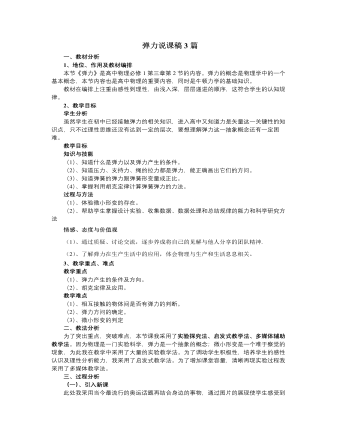
人教版新课标高中物理必修1弹力说课稿3篇
基于以上分析,为使本堂课围绕重点、突破难点,同时让学生在课堂教学中能力得到提高,我设计如下教学过程。(一)创设情景认识形变由同学们已有的形变知识入手,引入新课。教师演示:①弹簧的压缩形变;②弹簧的拉伸形变③视频播放:竹竿形变、钢丝的扭转形变。得出形变的概念及各类形变。[设计意图:我从生活情景中引入新课,是为了激发学生的好奇心,为学生学习重点和难点内容作铺垫。]设问:摩天大楼在风的吹拂下会不会摆动,发生形变吗?演示微小形变放大实验:由于这种形变不容易观察,会使学生产生疑问:到底有没有发生形变?解决的办法是微小形变的演示实验。为什么光点会往下移?让学生带着问题思考后得出结论:是由于桌面发生了形变,但是形变不明显。为后面解决压力和支持力都是弹力做好铺垫。[设计意图:使学生知道“放大”是一种科学探究的方法。]
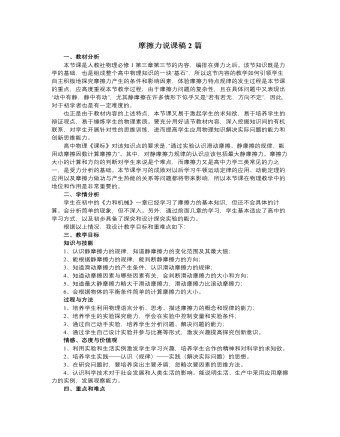
人教版新课标高中物理必修1摩擦力说课稿2篇
本节课是人教社物理必修1第三章第三节的内容,编排在弹力之后。该节知识既是力学的基础,也是组成整个高中物理知识的一块“基石”,所以这节内容的教学如何引领学生自主积极地探究摩擦力产生的条件和影响因素,体验摩擦力特点规律的发生过程是本节课的重点,应高度重视本节教学过程;由于摩擦力问题的复杂性,且在具体问题中又表现出“动中有静,静中有动”,尤其静摩擦在许多情形下似乎又是“若有若无,方向不定”,因此,对于初学者也是有一定难度的。也正是由于教材内容的上述特点,本节课又易于激起学生的求知欲,易于培养学生的辩证观点,易于锤炼学生的物理素质。要充分用好该节教材内容,深入挖掘知识间的有机联系,对学生开展针对性的思维训练,进而提高学生应用物理知识解决实际问题的能力和创新思维能力。高中物理《课标》对该知识点的要求是,“通过实验认识滑动摩擦、静摩擦的规律,能用动摩擦因数计算摩擦力”。其中,对静摩擦力规律的认识应该包括最大静摩擦力。
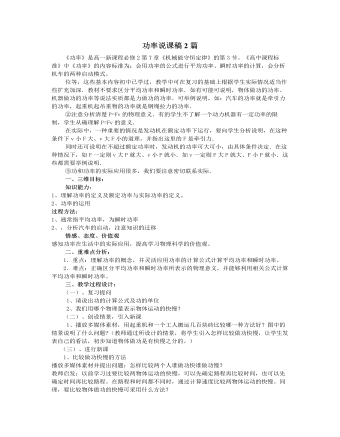
人教版新课标高中物理必修2功率说课稿2篇
(一)、复习提问1、请说出功的计算公式及功的单位2、我们用哪个物理量表示物体运动的快慢?(二)、创设情景,引入新课1、播放多媒体素材,用起重机和一个工人搬运几百块砖比较哪一种方法好?图中的情景说明了什么问题?(教师通过所设计的情景,将学生引入怎样比较做功快慢,让学生发表自己的看法,初步知道物体做功是有快慢之分的。)(三)、进行新课1、比较做功快慢的方法播放多媒体素材并提出问题:怎样比较两个人谁做功快谁做功慢?教师启发:以前学习过要比较两物体运动的快慢,可以先确定路程再比较时间,也可以先确定时间再比较路程。在路程和时间都不同时,通过计算速度比较两物体运动的快慢。同理,要比较物体做功的快慢可采用什么方法?
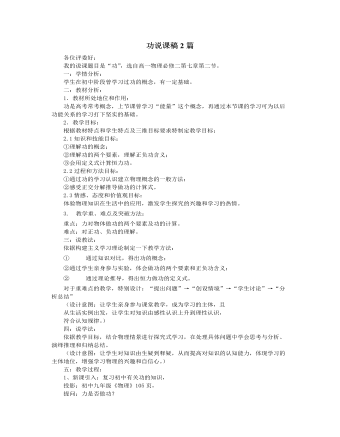
人教版新课标高中物理必修2功说课稿2篇
探究一:高中阶段功的含义是什么?投影:初中九年级《物理》105页学生思考:①图中物体的势能、动能分别如何变化?②物体能量的变化和做功是否存在关系?学生:分组讨论,得出结论:如果物体的能量发生变化时,说明有力对物体做了功。教师:进行点评和小结(设计意图:对初中知识深化理论认识,并为以后功能关系的教学作准备)探究二:力对物体做功的两个要素是什么?情景再现:找体重相对悬殊的两位同学,①A同学试图抱起B同学,但没成功。②B同学抱起A同学在教室内匀速走动。学生思考:在①中,A是否对B做功?在②中,B是否对A做功?学生:分析得出做功的两要素:物体受到力的作用,并且在力的方向上发生位移.教师:让学生分别例举生活中力对物体做功和不做功的例子,(设计意图:让学生亲身参与课堂实验,烘托课堂气氛,相互协作增进同学情谊)探究三:如果物体的位移不再力的方向上,那么力是否还对物体做功?
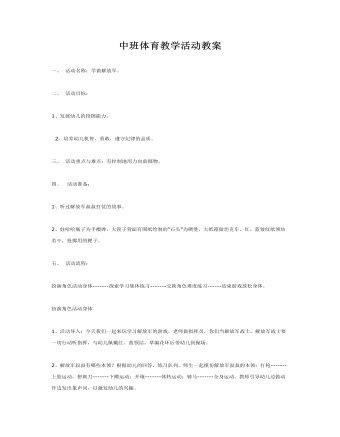
中班体育教学活动教案
二、 活动目标:1、发展幼儿的投掷能力。 2、培养幼儿机智、勇敢,遵守纪律的品质。三、 活动重点与难点:有控制地用力向前掷物。四、 活动准备:1、听过解放军叔叔打仗的故事。2、娃哈哈瓶子为手榴弹,大筐子背面有图纸绘制的“石头”为碉堡,大纸箱做坦克车。红、蓝皱纹纸领结若干,投掷用的靶子。

人教版新目标初中英语七年级上册Can you play the guitar教案
本单元主要是学习情态动词can的肯定句、否定句、一般疑问句,肯定与否定回答,以及特殊疑问句的构成和用法;复习what弓!导的特殊疑问句。本单元主要围绕“加人俱乐部,谈论自己的能力”这一话题,设计了三个任务型活动:任务一是:自己的才艺表演,学习情态动词can的用法;任务二是:自己建立俱乐部,运用情态动词can谈论自己在某一方面的能力、喜好和意愿;任务三是:我能成功,主要是复习巩固谈论各自的爱好和特长的方法。单元知识系统(树)Can you/he/she/you dance? 一Yes,I/he/she/we can./No,I/he/she/we can’t.Can Bill play the guitar?一Yes,he can,but he can’t sing.单元总体目标通过学习情态动词can的用法,使学生能够表达自己在某一方面所具备的才能;能够谈论自己的喜好与意愿;能够为自己成立的各种俱乐部制作海报;会写招聘广告。单元重难点一览重点 难点I.复习词汇:can,play,want2.词汇:guitar, dance, swim,sing, chess, speak, drum,trumpet,violin,play the guitar3.句型:Can you/he/she/you dance?Yes,I/he/she/we can./No,I/he/she/we can’t.Can Bill play the guitar?

人教版新目标初中英语七年级上册How much are these pants教案
个性练习设计 阅读广告:在日常生活中,人们去买东西之前,一般要阅读广告,从广告中获取该商品的一些有用信息,包括价格、性能等。所以给学生提供有些商品的广告或让学生去商店去阅读一些商品的广告,从中获取商品的价格,即可以锻炼学生的阅读能力,又能提高实践能力。 Self Check 教学内容 Self Check(教材P42) 教学目标 知识与能力 复习词汇pant,sock,T-shirt,sweater,shoes,color,black,white,red,green,blue,big,short,long,数字10--31; 学习词汇Zig Zag,clothes,shop,yellow,ask,which;学会谈论服装的价格、颜色、大小和长短;学会填写价格标签。 过程与方法 运用Summarizing和Classifying的学习策略。在复习教学中,运用听写、绘画、互相询问调查与检测等手段,促使学生不断地使用所学内容,从而提高他们灵活运用知识的能力。 情感态度价值观 该部分学习内容主要是复习谈论服装的价格和颜色以及对服装的喜好,能引起学生的共鸣;通过购物的对话练习教学生学会购物时使用的礼貌用语和如何感谢人。

人教版新目标初中英语七年级上册What time do you go to school教案
知识与能力复习词汇time,morning,breakfast,get up,g0 t0 bed,homework,clock,afternoon,lunch,run,watch TV,evening,dinner,eat,usually,o’clock,thirty,fifteen,take a shower,go t0 school等;引导学生复习、巩固“询问和谈论时间”的目标语言并运用所学知识安排自己的学习和课外活动。过程与方法运用Summarizing,Classifying和Comparing的学习策略。在复习教学中,运用听写、提问、对话演练与调查活动,促使学生不断地使用所学内容,从而提高他们灵活运用知识的能力。情感态度价值观本部分的主要内容是复习“日常作息时间”的询问和表达。通过互相询问或谈论自己或对方的作息时间安排和活动计划,培养学生良好的作息习惯和守时习惯。教学重、难点及教学突破重点复习词汇time,morning,breakfast,get up,g0 to bed,homework,clock,afternoon,lunch,run,watch TV,evening,dinner,eat,usually,o’clock,thirty,fifteen,take a shower,go to school等;引导学生复习、巩固“询问和谈论时间”的目标语言。

人教版新目标初中英语七年级上册What’s this in English教案
一、知识和能力目标本单元的核心教学内容是“认物”。用英语确认周围的常见事物比较符合英语初学者的实际情况。通过本单元教学,使学生运用所学句型,去熟悉周围事物的名称;教学生学会在实际生活中如何确认事物。通过辨认物体,学生学到一些生词,并巩固所学句型。二、过程和方法目标教师要尽量使学生对课文中出现的句型能够熟练上口,这样,学生才能顺利开展比较灵活的对话。教师可以用手势,表情,动作等示意,帮助学生听懂课堂教学内容,但在实际操作中应尽量避免“明知故问”的倾向,应该采用应用性原则;如:遮盖物品、显露局部、辨认物体、完形识别、图形辨认等方法。三、情感态度和价值观目标目标在学生学习过程中的作用至关重要,教师要帮助他们建立起一个切合自己实际的目标,通过渐进的学习以及一点一滴的进步,使他们逐步建立起成功感。成功越多,自信心就越强。

人教版新目标初中英语七年级下册Where is your pen pal from教案
2.1Match the country with the language.Step II Reading3a? let the students read the letter fast and answer the questions.? Let the students ask more questions about the letter as possible as the can.Step III Writing3b.Step IV. Pairwork2cStep V Listening2a, 2bStep V. HomeworkExercises book(1) P3Exercises book (2) P3Period FourStep I . Dictate the words and sentences in Unit1.Step II. Self-checkStep III. Check the answers for Exercises book in the unit.Step IV. Home workRevise and preparation for unit 2.教学反思:通过本单元的学习,学生基本可以谈论人们的国籍,居住城市及其所说的语言,通过书信方式去介绍自己并寻找笔友。但在涉及到国外的一些城市时,学生对这方面的知识相对欠缺,能介绍的城市并不多,也反应出学生课前预习不充分,这跟学生学习条件也有关,大多数学生无法通过网络获取所需信息。因此,在以后的教学中要多指导学生通过计算机网络获取信息,拓宽知识面。

人教版新目标初中英语七年级下册Where did you go on vacation教案
句型: Where did you go on vacation? I went to summer camp.Did she go to Central Park?Yes,she did.No, she didn’t语法:一般过去时特殊疑问句、一般疑问句及肯、否定回答。课时安排4课时第一课时:Section A:la,1b,lc,2a,2b,2c 第二课时:Section A:3a,3b,4第三课时:Section B:1,2a,2b,2c第四课时:Section B:3a,3b,3c,4 and Self Check第一课时教学目标掌握描写假期生活的形容词。假期里自己所做事情的简单表达。谈论假期做的事情及当时情况。谈论假期时旅游的天气,旅游者以及食物等。教学过程一、导入播放一首英文歌曲:Let’s travel 说明:通过让学生听节奏欢快迪斯尼英语歌曲Let’s travel.引入本节课谈论的话题vacation and travel. 让歌曲使学生的思维活跃,增强课堂气氛,激发学生提高学习英语的兴趣。T:How is the trip ?Ss : It’s pretty good/ happy/exciting /relaxing/busy/dangerous/ fantastic说明:这个问题是为了操练形容词。建议让多个Ss作答。鼓励他们用不同的形容词。上述个别形容词本应在第二课时中出现,但可以在warming-up中第一次非正式出现。这些形容词也可在老师的评价语中适时出现,以加深学生对词汇的印象。

人教版新目标初中英语九年级上册I used to be afraid of the dark教案
内容提示1.本单元主要内容是学会used to结构。Used to +动词原形表示过去经常、以前常常,只用于过去式中,用来表示现在已不存在的习惯或状态。例如:They used to play football together.他们过去常在一起蹋足球。(现在不在一起踢了)2.used to的疑问形式和否定形式为Did you use to…?和I didn’t use to… 也可以用Used you to…?和I used not to…但现在多使用前者。例如:Did you used to swim in the river? 你过去常在河里游泳吗?I didn’t use to play the piano. 我以前并不经常弹钢琴。教学目标一、学习目标(Language Goal) 1.学会陈述自己过去常做的事情。2.学会陈述自己过去的爱好等。3.能够表达自己现在和过去在外表、性格、娱乐等方面的变化。4.能够表达朋友、家人等现在和过去的变化。二、语言结构(Language Structures) 1.I used to be short when I was young. 我年轻时个子很矮。 2. —Did you use to have straight hair? 你过去是直发吗?—Yes, I did. 是的。 3. —Did you use to play the piano? 你过去弹钢琴吗?—No, I didn’t. 不,我不弹。 4.I used to be afraid of dark. 我过去害怕黑暗。 5.I’m terrified of the snakes. 我害怕蛇。

